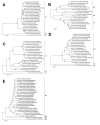Detection of rare G3P[19] group A rotavirus in human patient, Italy
- PMID: 25340712
- PMCID: PMC4214293
- DOI: 10.3201/2011.131699
Detection of rare G3P[19] group A rotavirus in human patient, Italy
Abstract
Infection with a rare G3P[19] rotavirus A strain was identified in an immunosuppressed patient in Italy. The strain showed a P[19] viral protein 4 gene and a complete AU-1-like genomic constellation. Phylogenetic analyses showed high nucleotide identity between this strain and G3P[19] rotavirus A strains from Asia, indicating possible reassortment events.
Figures


References
-
- Estes MK, Kapikian AZ. Rotaviruses. In: Knipe DM, Howley PM, editors. Fields virology. 5th ed. Philadelphia: Lippincott, Williams & Wilkins; 2007. p. 1918–74.
Publication types
MeSH terms
Associated data
- Actions
- Actions
- Actions
- Actions
- Actions
- Actions
- Actions
- Actions
- Actions
- Actions
LinkOut - more resources
Full Text Sources
Other Literature Sources
Medical

